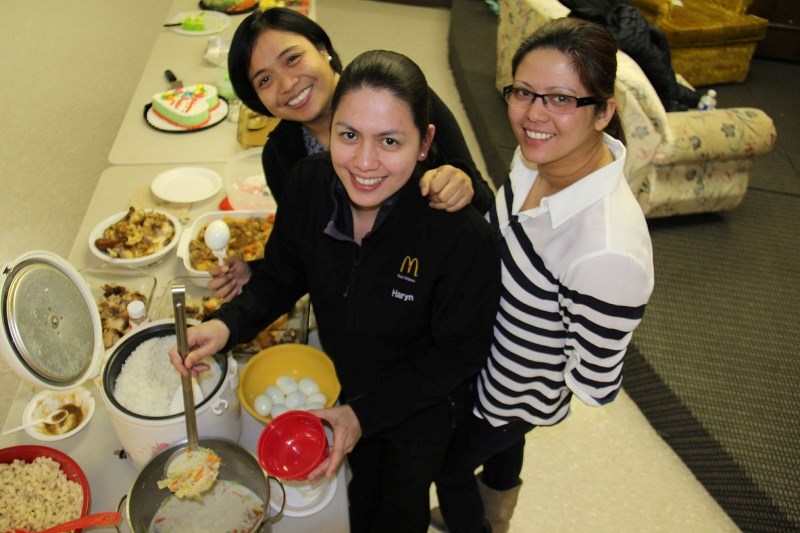Cherry Leano’s best Christmas was when her mother visited the Philippines from Germany when she was 13 years old.
She gave Leano a new pair of shoes (which she could wear to Christmas Eve mass), money and a winter jacket.
“It was my first Christmas with her, but hopefully not my last,” says Leano, 31, who moved to Canada a year later.
This Christmas will be her first in Alberta; the rest of her family now lives in B.C.
On Sunday, Leano celebrated Christmas with the congregation of Jesus Rock of Ages Ministries at Grace Family Church. Sixty per cent of the church's congregation is made up of temporary foreign workers; many will not be going home for Christmas.
The Sunday service was followed by a potluck feast of creamy chicken sopas (also known as macaroni soup), Adobo chicken with pineapple, roast pork, buko pandan (a dessert made from the leaves of the pandan plant, cream and young coconut) and of course … rice.
Food is the one thing Haryn Gamido, Leano’s housemate and colleague at McDonald’s, misses most about the Philippines, especially at Christmas.
Christmas in the Philippines is one of the world’s longest festive seasons.
Star-shaped Christmas lanterns, parols, are hung in households and businesses. Decorations are put up in the streets starting in September – all of the ‘-ber’ months are considered Christmas months – and they aren’t taken down until the Feast of the Epiphany on Jan. 6.
Street vendors sell snacks including bigingka, a thin cake made with sweet rice flour and cream of coconut, as well as puto bumbong, a delicacy of steamed glutinous rice in bamboo tubes, reminisces Gamido.
Tablea tsokolate, a bitter hot chocolate of sorts made from pure cacao nibs, sugar and boiled milk is drunk during the nine days leading up to Christmas Eve.
Leading up to Christmas, children go door-to-door in their towns to sing Christmas carols and are given a peso or two in return. They make tambourine-like instruments out of bottle caps and use empty cans as drums.
Jingle Bells and We Wish You A Merry Christmas are popular ones, says Leano.
Simbang Gabi is a devotional nine-day series of morning (as early as 4 a.m.) and evening masses, culminating in the Christmas Eve mass of Misa de Gallo.
Children open their presents before mass so they can wear their new clothes to church. After mass, the streets are packed with people going from house to house visiting with family and friends, says Gamido.
Children collect money and gifts, aginaldo, from relatives, which they can later spend to buy candies or piggy banks. People are out all night long.
“Here it’s winter and way too cold to do,” laughs Gamido, who came to Canada six years ago.
Firecrackers and fireworks are set off on Noche Buena, the traditional feast after midnight mass.
“It’s much quieter here,” notes Leano. “It’s not as festive and not as loud.”
Allin Posadas will be working to replicate that this Christmas Eve – a noisy and busy traditional Filipino feast and celebration at Max’s Restaurant in Edmonton where she works.
This will be her second Christmas in Canada and she is feeling more homesick than last, she says, but that is what she has the church for.
“Here you have an instant family that you can celebrate Christmas with. But we don’t celebrate Christmas just on one day, we celebrate everyday with each other,” says Posadas.




